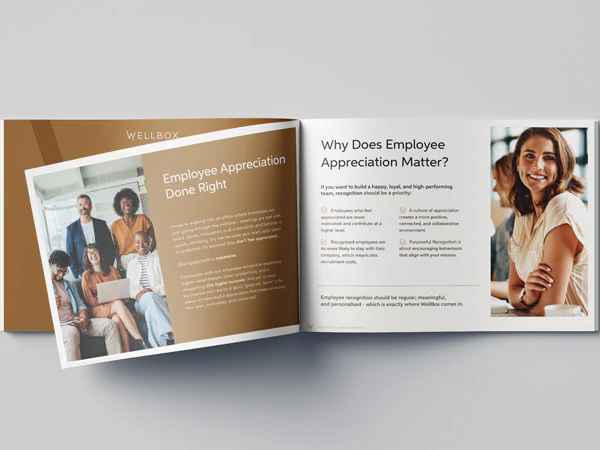Ah, the end-of-year review.
That magical time when managers scramble to remember what happened in Q1, employees dust off their “I really enjoyed collaborating with the team” line, and the shared goal is simply to make it through without crying (from either side).
But here’s a wild idea: what if we stopped treating year-end reviews like awkward HR speed dating?
Because let’s be honest – somewhere between “Let’s circle back in January” and “You’ve really demonstrated growth in… something,” we’ve lost the plot. And in today’s world, where watercooler chats are now just dodgy Wi-Fi and waving at someone’s cat on Zoom, we need to make more of these moments, not less.
End-of-year reviews can be meaningful. Thoughtful. Even (dare we say it?) enjoyable. They’re not just about ticking boxes or checking if someone hit their KPIs – they’re about pausing to reflect, celebrate, and ask: What’s next? What matters? And can snacks be involved?
(Yes. Yes, they can.)
We’re all about turning transactional moments into tangible ones. So if you’re ready to rethink your review season, and maybe even sneak in some joy, let’s talk about how to make year-end reviews not just useful, but unforgettable.
Why End-of-Year Reviews Still Matter (and Always Will)
Sure, they can feel like a formality. Like flossing, or reading the terms and conditions – we know we’re supposed to do them properly, but it’s tempting to rush through and hope for the best.
But end-of-year reviews are one of the few structured moments in the year where we actually stop and say, “Hey… how’s it really going?”
And that matters. A lot.
In between project deadlines, Zoom fatigue, and trying to remember where we saved that spreadsheet, it’s easy to forget the bigger picture. Year-end reviews pull us back to centre. They remind employees that their work didn’t go unnoticed. They help managers understand what’s working (and what’s wobbling). And they create space for those magical things that make work more than just, well, work: growth, purpose, recognition, and direction.
Even better? These reviews are a prime opportunity to boost engagement and retention – not through generic “Keep up the good work!” platitudes, but through real conversations. The kind that say, “You matter here. Let’s figure out what’s next – together.”
(Extra points if it comes with snacks. Just saying.)

Common Pitfalls in Year-End Reviews (That We’ve All Definitely Made)
Most of us are doing our best. But even with the best intentions, year-end reviews can quickly spiral into awkward HR theatre if we’re not careful.
Here are some of the greatest hits of what-not-to-do – and yes, we’re cringing with you.
1. The “Wait, What Do You Actually Do Again?” Review
Nothing says “I care” like opening a review by frantically scrolling through Slack to remember what your employee’s role actually involves. Spoiler: they notice. Take time to prepare. You’re not Sherlock Holmes – you don’t need clues. Just check their goals, projects, and performance data. It’s all there.
2. The One-Way Monologue
If your review sounds like a TED Talk (but without the standing ovation), it’s time to stop. Reviews should be conversations – not podcasts. If your team member hasn’t spoken in 20 minutes and is just nodding politely while slowly dying inside… that’s your cue.
3. The “Great Job!” Review with Zero Specifics
“You’re doing great!” is lovely… but also pretty useless. What was great? Why? Can they do more of it? Are you just trying to wrap this up before lunch? Be specific. Celebrate actual wins. Even better, bring receipts (AKA: examples).
4. Only Focusing on the Negative
Yes, we need to talk about growth areas. But if your review is 45 minutes of “here’s where you didn’t quite measure up,” followed by “anyway, happy holidays!” – don’t be surprised if motivation dips. Sandwich the feedback. Start with strengths, be honest about challenges, and end with something forward-looking and positive. No one grows in a shame spiral.
5. Forgetting the Human Element
Your team members aren’t just KPIs with legs. They’re real people, with lives, goals, and (probably) a plant that’s barely hanging on. Don’t skip the personal touch – a sincere “How are you feeling about this year?” can go a long way. And yes, giving a little thank-you gift never hurt either.
6. No Follow-Up = No Point
If your review ends in December and no one references it again until next December, it wasn’t a review – it was performance karaoke. Set goals. Schedule check-ins. Actually follow through. Progress needs direction, not déjà vu.
Avoiding these pitfalls won’t just make your reviews more effective, it’ll make your people feel seen, supported, and set up for success. And let’s be honest, that’s the kind of energy we all need heading into a new year.

5 Ways to Create a Meaningful Year-End Review Experience
Your team deserves more than a rushed 1:1 and a “Keep up the good work!”
1. Make It a Two-Way Conversation (Not a One-Man Show)
Look, you might be the manager, but this isn’t your performance. So if you’re doing 95% of the talking, it’s time to flip the script.
Let your team member share their wins, struggles, and dreams of being the person who finally cleans out the shared Google Drive. Ask open-ended questions like:
- What are you most proud of this year?
- What would you do differently if you had a time machine?
- What would make your work feel even more meaningful next year?
Remember: when people are given space to reflect, they take more ownership of their growth. Also, they’re more likely to walk away thinking, “Wow, they actually listened.”
2. Start With Recognition (Not a Spreadsheet)
Imagine walking into a meeting thinking you’re about to get roasted – and instead, someone kicks things off by saying, “You smashed it this year, and here’s how.”
Game-changer.
Leading with gratitude sets the tone for a positive, productive conversation. And no, we’re not talking about a vague “thanks for your hard work.” Get specific. Name projects, wins, client feedback – even that time they helped de-escalate an email thread that was about to go full Shakespearean drama.
Bonus points: Pair your praise with a small, personalised gift. (Yes, this is us gently nudging you toward one of our gifts. And yes, we do have options for coffee lovers, snackers, wellbeing enthusiasts, and everyone in between.)
3. Use Real Examples – Not Vibes
If your review sounds like “I just feel like you’ve been… doing okay?” then congratulations – you’ve officially entered the Vague Feedback Zone™.
Time to exit.
Instead, anchor your comments with real data:
- Targets hit (or missed)
- Feedback from peers or clients
- Specific projects or milestones
Tangible feedback builds trust. It shows your review isn’t based on a random Tuesday mood or whether someone kept their camera on during Zoom calls.
4. Connect Past Wins to Future Goals
Great reviews don’t just reflect – they project. Not in a spooky way, but in a “Where do we go from here?” kind of way.
Set goals collaboratively. Make them SMART (Specific, Measurable, Achievable, Relevant, Time Related – and not the kind of thing you scribble five minutes before a meeting). Discuss career aspirations. Ask where they want to grow, and how you (and the company) can help get them there.
This is also where you can bring learning and development into the mix. Online courses, mentoring, or even just the chance to lead a new project, it all shows that you’re investing in them long-term, not just ticking off an HR box.
5. Mark the Moment, Make it Memorable
This is the end of the year. The moment people take stock. The moment they decide whether to double down or dust off the CV.
So… don’t let it pass like just another meeting.
Wrap up the review with a moment of genuine appreciation, and yes, that could be something as simple as a handwritten note. Or, if you really want to go full “we value you”, what about a gift sent to their door. (Something we happen to be experts in.)
Because let’s face it: Slack emojis are fine. But a surprise delivery of luxury hot chocolate, wellness treats, or mood-boosting snacks? That’s culture.
When done right, end-of-year reviews are more than a formality – they’re a chance to connect, reflect, and reignite your team’s energy for the year ahead.
And with the right words, and maybe a gift or two, they might even look forward to them next year.
Bonus Tips: Making Year-End Reviews Shine in Remote & Hybrid Teams
Remember when reviews used to happen in a quiet meeting room with awkward small talk and lukewarm coffee? Now, it’s more like:
“Can you hear me okay?”
“Sorry, I was talking on mute.”
“Hold on, your face just froze.”
Welcome to the world of remote and hybrid work – where performance reviews happen between buffering and background pets.
But distance doesn’t have to mean disconnection. In fact, end-of-year reviews are even more important when you’re not sharing the same office snacks.
Here’s how to keep them meaningful from behind the screen:

1. Don’t Let It Feel Like Just Another Zoom Call
Let’s be real – if the review feels identical to the weekly team stand-up, you’ve already lost them.
- Change up the format. Use video, but personalise the conversation.
- Suggest they grab a coffee or tea and make it feel more like a chat than a checklist.
- Add a small moment of surprise – like a pre-scheduled calendar invite titled “Your Time to Shine ✨” instead of “Performance Review – FINAL DRAFT – v3”
2. Send a Review Prep Kit Ahead of Time
No one likes to be caught off guard with a “Let’s talk about your entire year in 30 minutes” moment.
Give your team member time to reflect by sending:
- Their previous goals
- A few guiding questions (e.g. “What are you most proud of?”/“Where did you feel stuck?”)
- A gentle reminder that this isn’t a trap
Pro tip: Include a surprise in the post beforehand so they show up already smiling. We recommend something snacky – snacks make self-reflection 37% more effective (okay, not scientifically proven, but still).
3. Create a Distraction-Free Environment (As Much as Possible)
Yes, remote life is full of interruptions – parcel deliveries, barking dogs, spontaneous existential dread – but do your best to block out a quiet window of time.
Turn off Slack. Set your status to “In Deep Focus Mode”. Encourage your team member to do the same. This signals: “This matters. You matter. Let’s give this moment the attention it deserves.”
4. Follow Up With a Human, Not Just a PDF
After the review, don’t just drop a cold Google Doc and disappear into the virtual mist.
Instead, send a short, heartfelt follow-up. Something like:
“Thanks again for the great chat today – I really appreciate your honesty and the work you’ve done this year. Excited about what’s ahead.”
That kind of message? It sticks. It also beats the classic “See you next quarter” energy.
5. Celebrate Wins From Afar
Nowadays, you have to go the extra mile to make recognition tangible.
Whether it’s a gourmet snack box or a self-care package that says “You did the thing!”, sending a physical token of appreciation is a small act with a big impact.
Because remote employees can’t feel the office vibes but they can feel valued when something thoughtful arrives on their doorstep.
Distance doesn’t have to dull the magic of a great review. With a little intention (and maybe a little chocolate), you can turn your remote performance conversations into powerful moments of connection.

Make Recognition Part of Your Review Culture (Because People Remember How You Made Them Feel)
Here’s the truth: your team probably won’t remember every bullet point from their end-of-year review. They might not recall the exact feedback you gave, or the clever acronym you used to describe next year’s goals.
But they will remember how they felt.
— Did they feel valued?
— Did they feel seen?
— Did they leave thinking, “Yes, I want to do more of this next year”?
If your answer is “Hmm… maybe?” – then here’s your opportunity.
Because recognition is culture-defining, retention-boosting, motivation-multiplying superpower. And embedding it into your review process is one of the smartest, simplest ways to show your team that you’re not just managing them – you’re championing them.
And if you want to make those moments tangible – We have your back.
💡 A little recognition goes a long way:
- A snack box that says “Thank you for your energy this year”
- A wellbeing kit that says “We care about you, not just your output”
- A cocktail set that says “You crushed it – now go celebrate”
Whether you’re wrapping up a wild Q4, recognising someone’s growth journey, or just trying to make remote reviews feel less like robot admin and more like a real connection – we’re here for it.

Bonus: A Simple, Thoughtful End-of-Year Review Template
If you’re not sure how to structure your review conversations (or you’re just tired of winging it), here’s a handy template to guide you. It’s designed to feel less like a formal interrogation and more like a meaningful check-in:
1. Reflections on the Year
- What are you most proud of this year?
- What challenges did you face, and how did you overcome them?
- What’s something you learned about yourself or your work?
2. Review of Goals & Performance
- How did you progress toward the goals we set?
- What went better than expected?
- What would you change or do differently?
3. Growth & Development
- What new skills or experiences would you like to gain next year?
- Are there areas where you’d like more support or training?
- What projects or responsibilities would you be excited to take on?
4. Manager & Team Support
- What’s one thing I could do to better support you?
- Is there anything we could improve as a team or company?
5. Looking Ahead
- What are your goals or focus areas for next year?
- How do you see your role evolving over time?
- And, of course – how can we make next year even better than this one?
Feel free to copy/paste this into your review doc, or adapt it for your own internal templates. And if you really want to level it up? Pair the conversation with a personalised WellBox gift. Because a great review says “We value you” – but a great review with snacks says “We really, really mean it.”
Transform Your End Of Year Review This Year
If you’ve made it this far, congrats – you’re clearly someone who cares about doing year-end reviews the right way (and not just because HR told you to).
At the heart of it all, performance reviews aren’t just about rating people on a scale of “meh” to “outstanding.” They’re about building trust, creating clarity, and reminding your team that they’re more than just a cog in the machine.
Done well, reviews can be the spark that reignites motivation, strengthens connection, and sets the tone for a great year ahead. And let’s face it – in a world of unread emails and virtual high-fives, a genuine, thoughtful moment of recognition stands out.
So whether you’re leading a team, managing a department, or just trying to make your own review a little more meaningful – pause, reflect, and make it count. Say thank you. Give actionable feedback. Ask good questions. And hey, maybe throw in a snack box for good measure.
Because the best reviews don’t just tick boxes – They build belonging.
👇Are You Struggling to Motivate Your Employees?👇
And if you’re looking for more support with your employee appreciation strategy, check out our Employee Appreciation Toolkit now. Inside you’ll find:
Celebrate Success Anywhere
Thoughtful, personalised gifts that go beyond merch — perfect for recognising your team’s impact.
Drive Engagement & Belonging
From onboarding to milestones, bring your employees together through shared moments that matter.
Be People-First & Purposeful
Support culture with meaningful gifts that give back, build connection, and make everyone feel valued.


